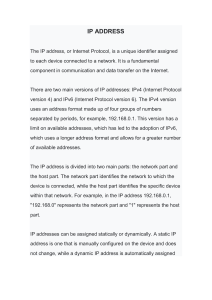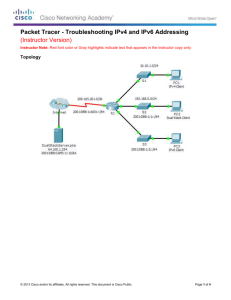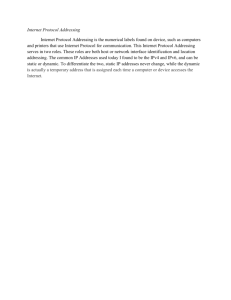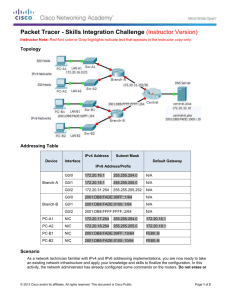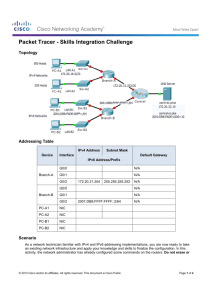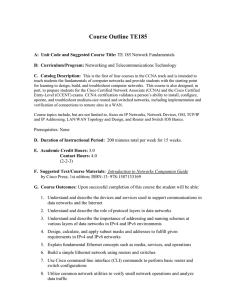7.3.2.5 Packet Tracer - Verifying IPv4 and IPv6 Addressing - ILM
advertisement
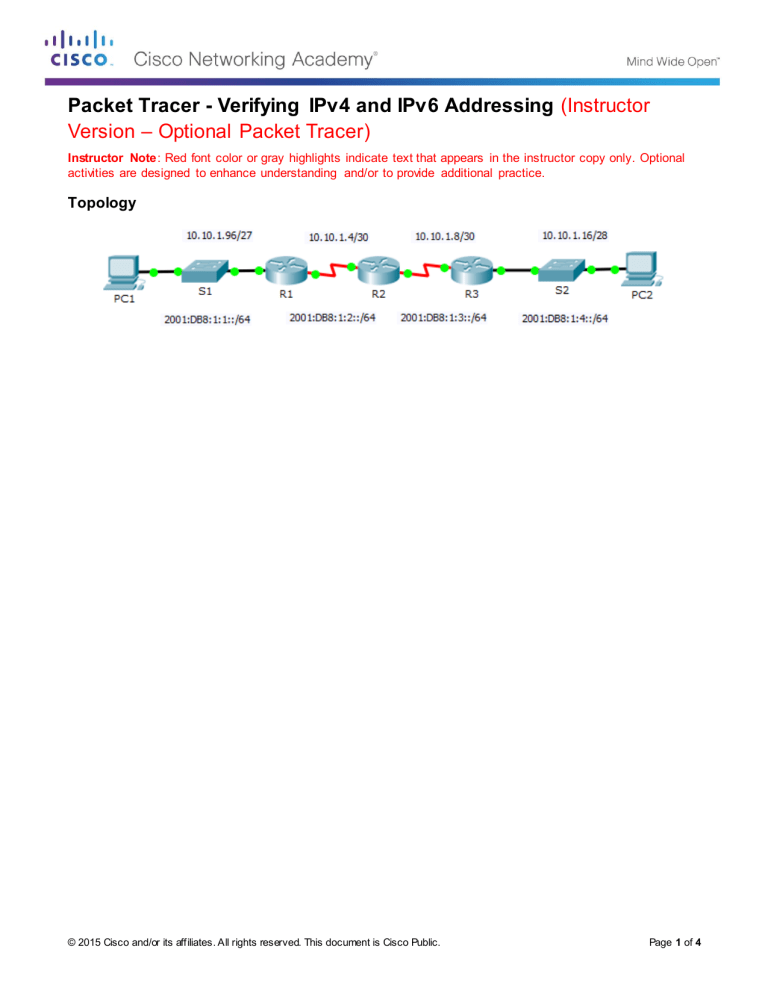
Packet Tracer - Verifying IPv4 and IPv6 Addressing (Instructor Version – Optional Packet Tracer) Instructor Note: Red font color or gray highlights indicate text that appears in the instructor copy only. Optional activities are designed to enhance understanding and/or to provide additional practice. Topology © 2015 Cisco and/or its affiliates. All rights reserved. This document is Cisco Public. Page 1 of 4 Packet Tracer - Verifying IPv4 and IPv6 Addressing Addressing Table IPv4 Address Device Subnet Mask Interface Default Gateway IPv6 Address/Prefix 10.10.1.97 255.255.255.224 N/A G0/0 2001:DB8:1:1::1/64 R1 10.10.1.6 N/A 255.255.255.252 N/A S0/0/1 Link-local S0/0/0 2001:DB8:1:2::2/64 N/A FE80::1 N/A 10.10.1.5 255.255.255.252 2001:DB8:1:2::1/64 R2 10.10.1.9 S0/0/1 Link-local N/A N/A 255.255.255.252 N/A 2001:DB8:1:3::1/64 N/A FE80::2 N/A 10.10.1.17 255.255.255.240 N/A G0/0 2001:DB8:1:4::1/64 R3 10.10.1.10 N/A 255.255.255.252 N/A S0/0/1 Link-local 2001:DB8:1:3::2/64 N/A FE80::3 N/A 10.10.1.100 PC1 255.255.255.224 2001:DB8:1:1::A/64 10.10.1.20 PC2 10.10.1.97 NIC FE80::1 255.255.255.240 10.10.1.17 NIC 2001:DB8:1:4::A/64 FE80::3 Objectives Part 1: Complete the Addressing Table Documentation Part 2: Test Connectivity Using Ping Part 3: Discover the Path by Tracing the Route Background Dual-stack allows IPv4 and IPv6 to coexist on the same network. In this activity, you will investigate a dualstack implementation including documenting the IPv4 and IPv6 configuration for end devices, testing connectivity for both IPv4 and IPv6 using ping, and tracing the path from end to end for IPv4 and IPv6. © 2015 Cisco and/or its affiliates. All rights reserved. This document is Cisco Public. Page 2 of 4 Packet Tracer - Verifying IPv4 and IPv6 Addressing Part 1: Complete the Addressing Table Documentation Step 1: Use ipconfig to verify IPv4 addressing. a. Click PC1 and click the Desktop tab > Command Prompt. b. Enter the ipconfig /all command to collect the IPv4 information. Fill in the Addressing Table with the IPv4 address, subnet mask, and default gateway. c. Click PC2 and click the Desktop tab > Command Prompt. d. Enter the ipconfig /all command to collect the IPv4 information. Fill in the Addressing Table with the IPv4 address, subnet mask, and default gateway. Step 2: Use ipv6config to verify IPv6 addressing. a. On PC1, enter the ipv6config /all command to collect the IPv6 information. Fill in the Addressing Table with the IPv6 address, subnet prefix, and default gateway. b. On PC2, enter the ipv6config /all command to collect the IPv6 information. Fill in the Addressing Table with the IPv6 address, subnet prefix, and default gateway. Part 2: Test Connectivity Using Ping Step 1: Use ping to verify IPv4 connectivity. a. From PC1, ping the IPv4 address for PC2. Was the result successful? Yes b. From PC2, ping the IPv4 address for PC1. Was the result successful? Yes Step 2: Use ping to verify IPv6 connectivity. a. From PC1, ping the IPv6 address for PC2. Was the result successful? Yes b. From PC2, ping the IPv6 address of PC1. Was the result successful? Yes Part 3: Discover the Path by Tracing the Route Step 1: Use tracert to discover the IPv4 path. a. From PC1, trace the route to PC2. PC> tracert 10.10.1.20 What addresses were encountered along the path? 10.10.1.97, 10.10.1.5, 10.10.1.10, 10.10.1.20 With which interfaces are the four addresses associated? G0/0 of R1, S0/0/0 on R2, S0/0/01 on R3, NIC of PC2 b. From PC2, trace the route to PC1. What addresses were encountered along the path? 10.10.1.17, 10.10.1.9, 10.10.1.6, 10.10.1.100 With which interfaces are the four addresses associated? G0/0 of R3, S0/0/1 of R2, S0/0/1 of R1, NIC of PC1 Step 2: Use tracert to discover the IPv6 path. a. From PC1, trace the route to the IPv6 address for PC2. PC> tracert 2001:DB8:1:4::A © 2015 Cisco and/or its affiliates. All rights reserved. This document is Cisco Public. Page 3 of 4 Packet Tracer - Verifying IPv4 and IPv6 Addressing What addresses were encountered along the path? 2001:DB8:1:1::1, 2001:DB8:1:2::1, 2001:DB8:1:3::2, 2001:DB8:1:4::A With which interfaces are the four addresses associated? g0/0 of R1, S0/0/0 of r2, S0/0/1 of R3, NIC of PC2 b. From PC2, trace the route to the IPv6 address for PC1. What addresses were encountered along the path? 2001:DB8:1:4::1, 2001:DB8:1:3::1, 2001:DB8:1:2::2, 2001:DB8:1:1::A With which interfaces are the four addresses associated? Ga0/0 of R3, S0/0/1 of R2, S0/0/1 of R1, NIC of PC1 Suggested Scoring Rubric Activity Section Part 1: Complete the Addressing Table Documentation Question Location Possible Points Step 1b 10 Step 1d 10 Step 2a 10 Step 2b 10 Part 1 Total Part 2: Test Connectivity Using Ping Part 3: Discover the Path by Tracing the Route 40 Step 1a 7 Step 1b 7 Step 2a 7 Step 2b 7 Part 2 Total 28 Step 1a 8 Step 1b 8 Step 2a 8 Step 2b 8 Part 3 Total 32 Total Score 100 © 2015 Cisco and/or its affiliates. All rights reserved. This document is Cisco Public. Earned Points Page 4 of 4
